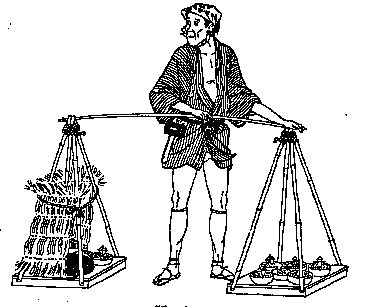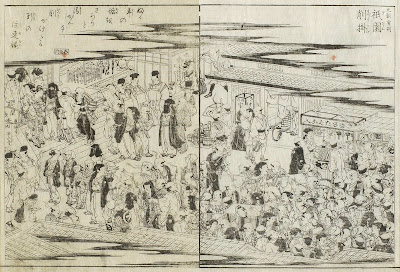- kibigara zaiku きびがら細工 craft see below -
::::::::::::::::::::::::::::::::::::::::::::::::::::::::::::::::::::::::::::::::::::::::::::::::::::
Millet, barn millet (hie)
***** Location: Japan
***** Season: Various, see below
***** Category: Plant / Humanity
*****************************
Explanation
Foxtail millet (awa), barn millet (hie) and egg millet (kibi) was the food of the poor farmers, who had to give away their rice crop as taxes to the authorities. It was not considered a weed since olden times.
Now it is often used to feed the birds.


:::::::::::::::::::::::::::::::::::::::::::::::::::::::::::::::::::::::::::::::::::::::::::::::::::::
humanity kigo for early summer
awa maki 粟蒔 (あわまき) sowing of foxtail millet
..... awa maku 粟蒔く(あわまく)sowing foxtail millet
.................................................................................
kigo for mid-summer
sowing of barn millet, hie maki 稗蒔 (ひえまき)
..... hie maku 稗蒔く(ひえまく)
During the Edo period, this was a kind of bonsai that could be kept in a small home or garden to feel the coolness of a large field. Sometimes small dolls were inserted in the trays.
kibi maki 黍蒔 (きびまき) sowing of egg millet
..... kibi maku 黍蒔く(きびまく) sowing egg millet
Panicum miliaceum
seller of milled plants, hiemaki uri
稗蒔売 (ひえまきうり)

© singingsand
This vendor sells small pots with barn millet bonsai. His loud call "hie maaakyaa, hie maaki" ひえまアきア、ひえまアき was quite popular in Edo. Sometimes milled seeds were put into pine cones, watered well and put up as green field or green forest images.
Here is a senryu from the Edo period
稗蒔になるとかかしを母はつけ
hie maki ni naru to kakashi o haha wa tsuke
sowing millet
mother puts up a
scarecrow too
:::::::::::::::::::::::::::::::::::::::::::::::::::::::::::::::::::::::::::::::::::::::::::::::::::::
kigo for early autumn
nobie 野稗 (のびえ) wild millet
inuhie, inu hie 犬稗(いぬひえ)"dog's millet"
..... keinu hie 毛犬稗(けいぬひえ)
mizuhie, misu hie 水稗(みずひえ)"water millet"
kusabie 草稗(くさびえ)"weed millet"
tabie 田稗(たびえ)"field millet"
. . . CLICK here for Photos !
suzume no hie 雀の稗 (すずめのひえ)
millet for the sparrows
Paspalum thunbergii Kunth
. . . CLICK here for Photos !
. . . . .
kigo for mid-autumn
awa 粟 (あわ) foxtail millet
Setaria italica
awa no ho 粟の穂(あわのほ)ears of foxtail millet
awamochi 粟餅(あわもち)cakes with foxtail millet
awameshi 粟飯(あわめし)rice with foxtail millet
awabatake 粟畑(あわばたけ)field of foxtail millet
. . . . .
hie 稗 (ひえ) barn millet
Echinochloa esculenta
..... 穇(ひえ)
hatabie 畑稗(はたびえ)field with barn millet
..... tabie 田稗(たびえ)
hie kari 稗刈(ひえかり)cutting millet, harvesting millet
..... hie hiku 稗引く(ひえひく)
kibi 黍 (きび) egg millet
Panicum miliaceum
kibi no ho 黍の穂(きびのほ)ears of egg millet
kibi karu 黍刈る(きびかる) cutting egg millet, harvesting egg millet
..... kibi hiku 黍引く(きびひく)
kibihata, kibi hata 黍畑(きびばた)field with egg millet
kibidango, kibi dango 黍団子(きびだんご)millet dumplings
a speciality of Okayama prefecture
:::::::::::::::::::::::::::::::::::::::::::::::::::::::::::::::::::::::::::::::::::::::::::::::::::::
kigo for the New Year
Ears of foxtail millet and barn millet, awa bo hie bo
粟穂稗穂(あわぼひえぼ)

This is part of a Shinto ritual for the new year, to make sacred sticks or branches of willows or cypresses shaved to resemble ears of reed, kezurikake 削掛 (けずりかけ).
It was popular in the Gion quarters of Kyoto.
Ritual of shaving branches at the Gion quarters in Kyoto,
Gion kezurikake no shinji
祗園削掛の神事(ぎおんけずりかけのしんじ)

© www.nichibun.ac.jp
*****************************
Worldwide use
India
Millet is considered to be the poor, or not-so-privileded people's food in India.
The staple diet is considered of wheat and rice.
Millet is not popular.
Sunil Uniyal
New Delhi
:::::::::::::::::::::::::::::::::::::::::::::::::::::::::::::::::::::::::::::::::::::::::::::::::::::
Kenya
. millet (wimbi)
and posho mills
:::::::::::::::::::::::::::::::::::::::::::::::::::::::::::::::::::::::::::::::::::::::::::::::::::::
Yemen
Millet, sorghum [looks like big millet] and maize as main food crops in Yemen.
It's not just millet. It is pearl millet (Pennisetum glaucum), finger millet and little millet. They are used for human food in the form of flour. In Lahaj very common Khamir lahaji, baked in traditional ceramic ovens [Moufa].
Very delicious with white and red beans.
Or from the flour they make thick porridge Aseed. I know white Aseed and red Aseed. The white one is done with natural joghurt and the red one with dates [therefor very sweet]. They serve Aseed with Gulgul oil.
millet planting - mid summer [June]; rain and post-rainy season
millet harvest -- towards end of the year; late autumn - early winter [October-November]
regions:
Sana'a, Taiz, Ibb, Hodeijda, Tihama with almost desert conditions [North]
Lahaj and Abyan Deltas [South]
it all started
with a patch of dirt -
millet planting
***
at eye level
millet grains -
farmers march in
***
some heads pop up
some disappear -
millet harvest
Heike Gewi
YEMEN SAIJIKI
*****************************
Things found on the way
kibigarazaiku, kibigara zaiku きびがら細工
handicraft made from millet
millet is used to make many thinks, like brooms and dolls. The forms of ships, people, animals and vehicles are popular.

source : kibigarazaiku.html - 丸山早苗
Zodiac Animals, made by Maruyama Sanae

Chicken, by Aoki Yukio 青木行雄

Dog from Tochigi
. Inu 戌 / 犬 Dog dolls .
. Tochigi Folk Art - 栃木県 .
Kanuma town 鹿沼
. kibigara anesama きびがら姉様 .
"elder sister dolls" from dried skin of maize.
Made in Inaba, Hoki and the Izumo region.

*****************************
HAIKU

stone memorial at temple Gedatsu-Ji 解脱寺
粟稗にとぼしくもあらず草の庵
awa hie ni toboshiku mo arazu kusa no io (an)
- or
粟稗にまづしくもなし草の庵
awa hie ni mazushiku mo nashi kusa no an
foxtail and barn millet
are not scarce at all -
this thatched hut
Tr. Gabi Greve
Written on the 20th day of the 7th lunar month, 1688
貞亨5年7月20日, Oi Nikki 笈日記
At the home of Chookoo 長虹 Choko in Nagoya.
Greeting hokku for a kasen 七吟歌仙 with his disciples.
Choko was a priest at the temple Gedatsu-Ji 解脱寺 in Nagoya.
In the temple compound was the "grass hut" Chikuyooken 竹葉軒 Chikuyo-Ken, "Hermitage of Bamboo Leaves".
Basho observes that the priest had enough to eat, but it was very simple fare, just all kinds of millet, not even rice.
quote
Millet abounding
there’ s no scarcity of food
at the thatched hut
In this haiku Basho compares Choko to Jin Li, who Tu Fu mentions in a poem:
Hermit Jin Li wearing his dark hood
Who’s good at harvesting taros and millet.
- Tr. and Comment : Bill Wyatt
MORE - hokku about the hut
. Matsuo Basho 松尾芭蕉 - Archives of the WKD .
.............................................................................

stone memorial at the temple Seigan-Ji 誓願寺, Nagoya
よき家や雀よろこぶ背戸の粟
yoki ie ya suzume yorokobu sedo no awa
what a splendid house -
the sparrows are delighted
with millet at the back door
Tr. Gabi Greve
Written on the 8th day of the 7th lunar month, 1684
貞亨元年7月8日
This became the hokku for a kasen 歌仙.
A congratulation to the younger brother of Chisoku in Narumi 鳴海の知足亭 on the building of his new home.
Brother 下里三郎右衛門 Shimosato Saburoemon.
. Shimosato Chisoku 下里知足 .
such a fine house -
out back, sparrows delight
in the millet field
Tr. Barnhill
:::::::::::::::::::::::::::::::::::::::::::::::::::::::::::::::::::::::::::::::::::::::::::::::::::::
稗蒔や疲れたる眼にみどりなり
hie maki ya tsukaretaru me ni midori nari
millet plants -
pleasant greenery for
my tired eyes
Tomiyasu Fuusei 風生 Fusei
Tr. Gabi Greve
:::::::::::::::::::::::::::::::::::::::::::::::::::::::::::::::::::::::::::::::::::::::::::::::::::::

ひへ餅にあんきな春が来たりけり
hie mochi ni anki na haru ga kitari keri
enjoying millet dumplings
as spring enfolds
peacefully
together with millet dumplings
this spring has come
peacefully
Issa
Tr. Gabi Greve
HARU , spring, might also point to the New Year, according to the Asian lunar calendar.
*****************************
Related words
***** . hatomugi 鳩麦(はとむぎ) Job's tears; tear grass
"dove mugi". Coix lacryma-jobi
***** Saijiki of Japanese Ceremonies and Festivals
. Sowing and planting in summer
:::::::::::::::::::::::::::::::::::::::::::::::::::::::::::::::::::::::::::::::::::::::::::::::::::::::::::::::::::::::::::
[ . BACK to DARUMA MUSEUM TOP . ]
[ . BACK to WORLDKIGO . TOP . ]
- #kibi #millet #kibikara -
:::::::::::::::::::::::::::::::::::::::::::::::::::::::::::::::::::::::::::::::::::::::::::::::::::::::::::::::::::::::::::






4 comments:
millet beer?
In west Africa, varieties of millet are commonly fermented and drunk 'live'. As well as it being a staple food of course.
里宮に黒駒太子黍の秋
satomiya ni Kurokoma Taishi kibi no aki
at the mountain shrine
resides Taishi on his Black Horse -
millet in autumn
Nishimoto Itto 西本一都 (1907 - 1991)
MORE about village shrines
Yosa Buson
furudera ni kibigara o taku bojitsu kana
At an old temple
Millet chaff they burn--
At sunset
Tr. Nelson/Saito
Niigata 新潟県
yamabato 山鳩 "mountain dove"
In most parts of Niigata the farmers know: when the yamabato calls it is time to plant アワ awa foxtail millet. The bird is even called
awamakidori アワマキドリ
.
http://omamorifromjapan.blogspot.jp/2015/07/hato-dove-art-motives.html
Post a Comment